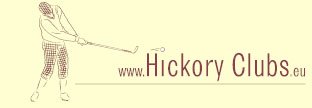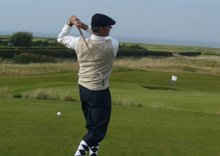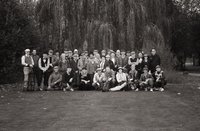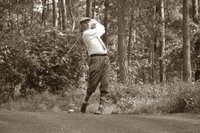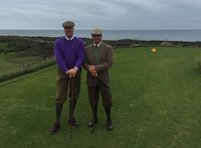Hickory Clubs.eu
Golf as it was meant to be
History
Golf was so popular in Scotland in 1457 that the king found it necessary to ban it. No clubs exist today from this period, but they probably were to similar to the oldest known clubs that date from 1600. The famous Troon clubs (see photo) from this period consist of. 6 long nose woods and 2 spur nose irons and were very probably owned by King James the 6th of Scotland.
The clubs from the 17th and 18th century were not signed by the makers, but the names of several makers can be found in royal archives. The earliest club makers were probably bow and spear makers that had the skill necessary to produce clubs. Most of the clubs were long nose play clubs (see photo left under), usually with 5 or 6 different lofts, irons were scarce in this period because they could easily damage the very expensive feathery ball.
Most of the players would only have one iron, initially a spur nose heavy iron and in later times a track iron. (see photo above right) these irons very only used in situations where playing with a wood was impossible.
In the late 18th and 19th centuries makers of golf clubs started to mark their name onto clubs. Legendary names such as, Dickson, Cossar, Philps en McEwan were among the first to be found. The heads of long nose clubs were made from beech and the shaft from ash or hickory, the grip was usually made from soft sheepskin.
The heads were long and slender and only with the arrival of the first rubber ball the gutty (see photo belows right) in 1848 did the woods become was thicker and stronger.
In round about 1890 the shape of woods started to change tot hat of what we now think of as modern woods, this club was called the bulger and the head was usually attached to shaft with a modern socket joint instead of the old scare joint.
After the arrival of the gutty (see photo above right), irons began to become more and more popular. Local blacksmiths tried to make some extra money by making a few irons, and when they were accepted the often turned to full time cleek making. Anderson, Carrick (see photo), White and Gray are a few of the earliest makers. These makers started to stamp their name on their clubs and after a few years started using symbols (cleekmarks), today these symbols are used to date old clubs.
In 1880 almost every club ever made was produced in Scotland (90% within 15km van St Andrews); from 1890 a few company’s started to produce clubs first in England and then also in America. Round the turn of the century some of the most famous names in clubmaking were at their prime, (Condie Stewart, Gibson en Gourlay).
The faces of clubs remained smooth until 1905 and these clubs are today the most prized by collectors. After 1905 manufacturers start punching dots on iron faces to create more backspin, and after 1910 dots were often replaced by lines/ grooves (see Photo).
Hand forged irons were made of steel and were vulnerable to rusting, round 1920 manufactures started using stainless steel. With the arrival and eventual legalization (1929) of steel shafts, the demand for hickory’s started to diminish, by 1935 the production of hickory clubs had stopped.
In the past clubs had names instead of numbers. The names of the clubs often found in a circa 1900 set (see photo) are listed here under.
Driver = Driver
Spoon = +- 3 wood
Cleek = +- 1 iron
Mid iron = +- 4iron
Mashie = +- 6 iron
Mashie niblick = +- 8 iron
Niblick = +- Pitchting wedge
Putter = Putter
